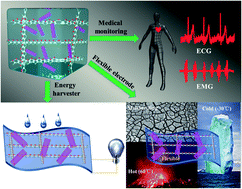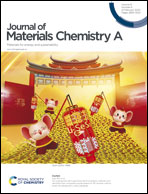Anti-freezing and moisturizing conductive hydrogels for strain sensing and moist-electric generation applications†
Abstract
Conductive hydrogels are attracting increasing attention for applications in wearable and flexible strain sensors, due to their excellent conductivity and mechanical properties. However, conventional conductive hydrogels lack anti-freezing and moisturizing properties and thus cannot be used as sensors under relatively harsh conditions, due to the use of pure water as the dispersion medium. In addition, conventional hydrogels cannot generate electric power, which is an essential requirement for practical applications in hydrogel-based strain sensors. Herein, a conductive hydrogel was fabricated by incorporating tannic acid–carbon nanotubes (TA–CNTs) into a polyvinyl alcohol (PVA) matrix containing a water–glycerol dispersion medium. The TA–CNT–glycerol–PVA (TCGP) hydrogel possessed excellent anti-freezing properties (−30 °C), long-term moisturizing performance (10 days), and outstanding sensitivity. Moreover, the TCGP hydrogel could be used not only as a strain sensor for the detection of various human motions, but also as an electrode for detecting human electrophysiological signals even in a relatively harsh environment. More importantly, a TCGP hydrogel-based moist-electric generator could generate electric power from moisture flow. These outstanding advantages highlight the great potential of the TCGP hydrogel in wearable flexible strain sensors, bioelectrodes, and next-generation green energy-generating devices.



 Please wait while we load your content...
Please wait while we load your content...